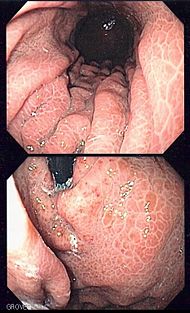Portal hypertensive gastropathy endoscopy
|
Portal Hypertensive Gastropathy Microchapters |
|
Differentiating Portal Hypertensive Gastropathy from other Diseases |
|---|
|
Diagnosis |
|
Treatment |
|
Case Studies |
|
Portal hypertensive gastropathy endoscopy On the Web |
|
American Roentgen Ray Society Images of Portal hypertensive gastropathy endoscopy |
|
Directions to Hospitals Treating Portal hypertensive gastropathy |
|
Risk calculators and risk factors for Portal hypertensive gastropathy endoscopy |
Please help WikiDoc by adding more content here. It's easy! Click here to learn about editing.
Editor-In-Chief: C. Michael Gibson, M.S., M.D. [1]
Overview
Endoscopy

The diagnosis of portal hypertensive gastropathy is usually made on endoscopy. The usual appearance of portal hypertensive gastropathy on endoscopy is a mosaic-like or reticular pattern in the mucosa. Red spots may or may not be present. The pattern is usually seen throughout the stomach. A similar pattern can be seen with a related condition called gastric antral vascular ectasia (GAVE), or watermelon stomach. However, in GAVE, the ectatic blood vessels are more commonly found in the antrum or lower part of the stomach.